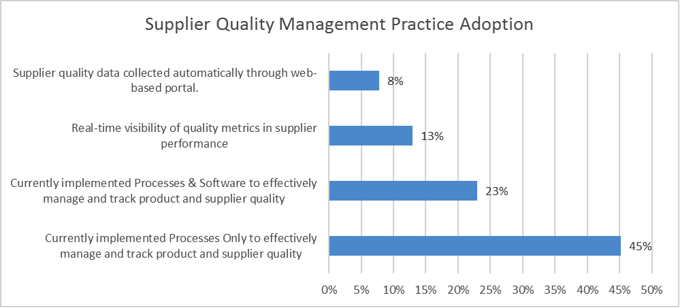Supplier Quality Management (SQM) is a top of mind concern for Quality leaders. In recent years it has grown in importance, and today quality leaders have disruptive new technologies at their disposal to achieve market leadership.
Click here to speak with Dan
Over the past decades, and under the influence of Quality gurus such as Juran, Crosby, Deming and others, progressive Quality leaders have identified and deployed effective Supplier Quality Management processes and perspectives. Some have also deployed SQM technology to automate these processes, provide visibility to supplier performance, foster collaboration and build a foundation of quality in the supply chain.
These progressive quality leaders were able to differentiate the quality of their products, using the best processes, perspectives, and technologies to establish a position of SQM market leadership. However, as the market, tools, and regulations change, so too does the definition of market leadership.
A Historical Perspective on SQM
A few decades ago, the efforts of market leaders were focused on deploying robust SQM processes, led by a team of trained Supplier Quality Engineers (SQEs). Harmonizing and institutionalizing robust SQM processes was a critical first step for all organizations with an important or complex supply chain, and remains a critical first step today.
A decade ago, leadership in SQM was achieved by automating these robust processes with a mix of enterprise workflow apps to manage and store SQM deliverables. These were often homegrown or heavily customized deployments that centralized data, while much of the actual work was performed in spreadsheets, desktop tools, and disparate enterprise systems.
Many Companies Are Still Stuck in a Decades-Old Mindset
While market leaders have incorporated technology into their Operational Excellence model, there are many that still prioritize process to the exclusion of technology. Many Quality professionals still use and recommend the desktop solutions and spreadsheets of yesteryear, stopgaps that create substantial challenges in quality management operational excellence.
This indicates that much of industry has low maturity SQM operational excellence. LNS has a useful definition of maturity (here's a useful post).
The Market Majority is Not Prioritizing SQM Technology…
As industry matures, it should recognize the value of technology to people and process. Interestingly, we are not seeing a broad-based increase in SQM technology adoption, with a few exceptions. Below is a subset of SQM practices that are tracked by LNS Research, and selected to highlight the discrepancy between process adoption and technology adoption. Note the low levels of adoption of technology.
This data was also analyzed over time, and interestingly, the adoption rates for the bottom three items did not change much from 2012 through the end of 2015. Therefore, not many joined the ranks of those that implemented Processes and Software to effectively manage and track product and supplier quality over this time.
The exception was automated data collection through a web portal – this grew from 6% in 2012 to just over 11% by the end of 2015.
…While Market Leaders Continue to Invest, Creating an Expanding Gulf
One interpretation of this information is that there is a growing dichotomy in the market. Market leaders have invested in SQM, and upon realizing benefits continue to make incremental investments to further improve performance. The market majority is lagging in maturity and is either still focused on process harmonization, or lacks the data to illustrate the value of technology in SQM.
It’s likely a mix of both. A common theme among quality leaders (VPs, Global Directors) is that the data does not exist to build a meaningful business case for quality, such that an investment in quality can get priority over other possible investments. It’s easier for a market leader to gain incremental investment, since there is a virtuous cycle of quality success, executive sponsorship and cultural support.
However, Technology Is Leveling the Playing Field…
Today, software vendors, such as EQMS vendors, capture and automate many SQM processes out of the box. These out of the box configurations are based on the lessons learned over the past one or two decades of EQMS and SQM deployments.
The arrival of enterprise software with out-of-the-box SQM deployments is important both to market leaders and the market in general. For the general market, out of the box enterprise SQM software makes SQM management and automation more affordable and quick to deploy.
Those who have heavily customized SQM deployments should look towards newer out-of-the-box configurations as a way to gain nimbleness. Upgrading heavily customized software can be very expensive and time consuming, and pushes IT into a software development role. Want a new feature? Maybe IT can code it for you, but now you’ve just made your future upgrade more difficult and expensive.
…Which Opens the Door for New Leaders
Out of the box SQM processes captured within Enterprise technology creates the opportunity for parity. It allows a late comer to deploy processes and flexible technology in an agile manner without the need and overhead of building and maintaining cumbersome customizations. It even helps address people, as training is also pre-packaged in some cases.
This can level the playing field. However, new technologies are emerging that can create disruption.
How Will You Lead Tomorrow?
By understanding and optimizing SQM’s extended Operational Excellence model.
This is the first part of a multi-part series in SQM. In the next post, we’ll discuss SQM’s extended Operational Excellence and important optimization considerations for Quality leaders.
Access this NEW eBook, "Manufacturing Metrics in an IoT World: Measuring the Progress of the Industrial Internet of Things," presents results from the fourth iteration of the biennial Metrics that Matter research study conducted between LNS Research and MESA International. It places particular focus on what IIoT means to manufacturers in the MOM space.